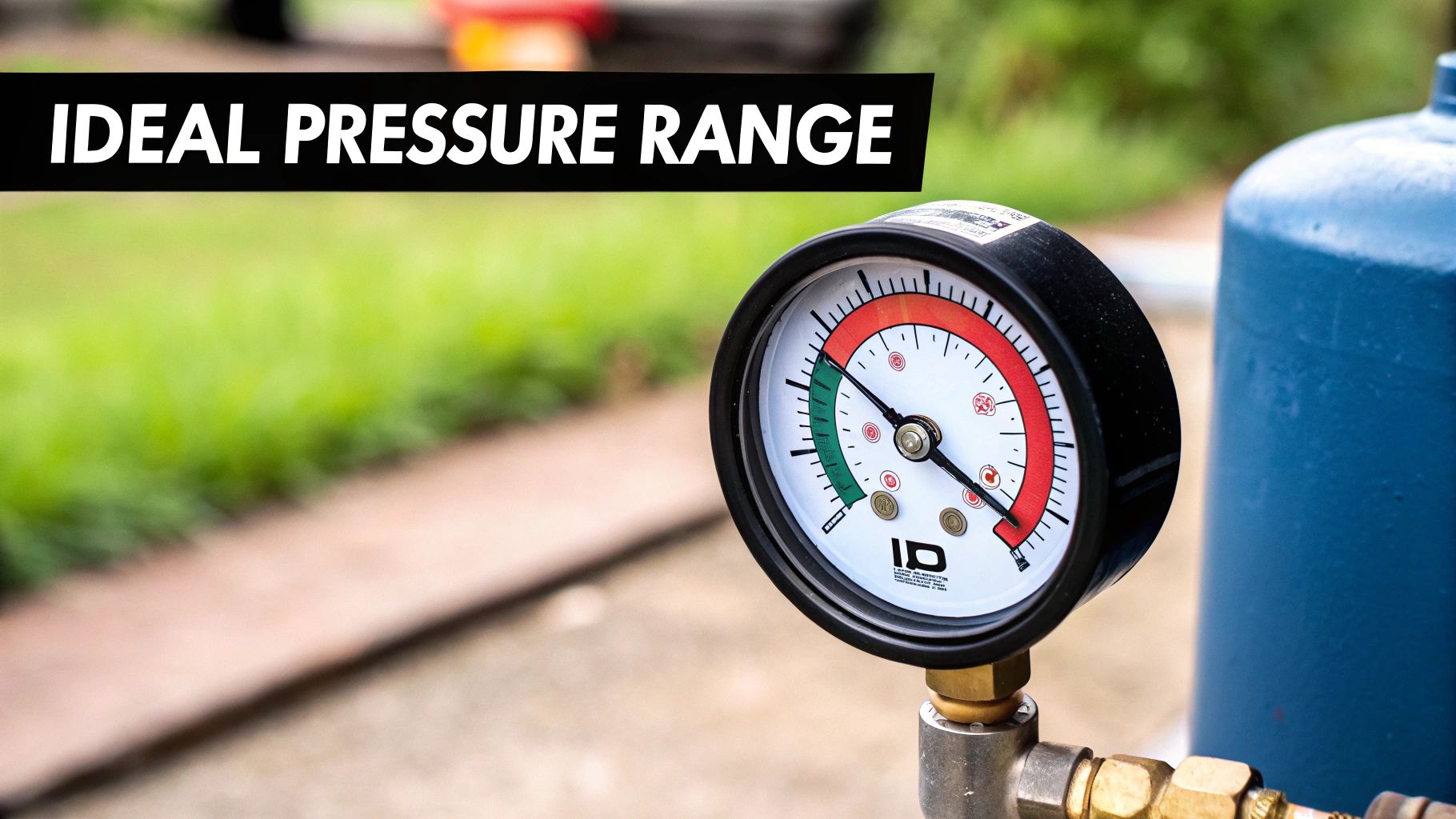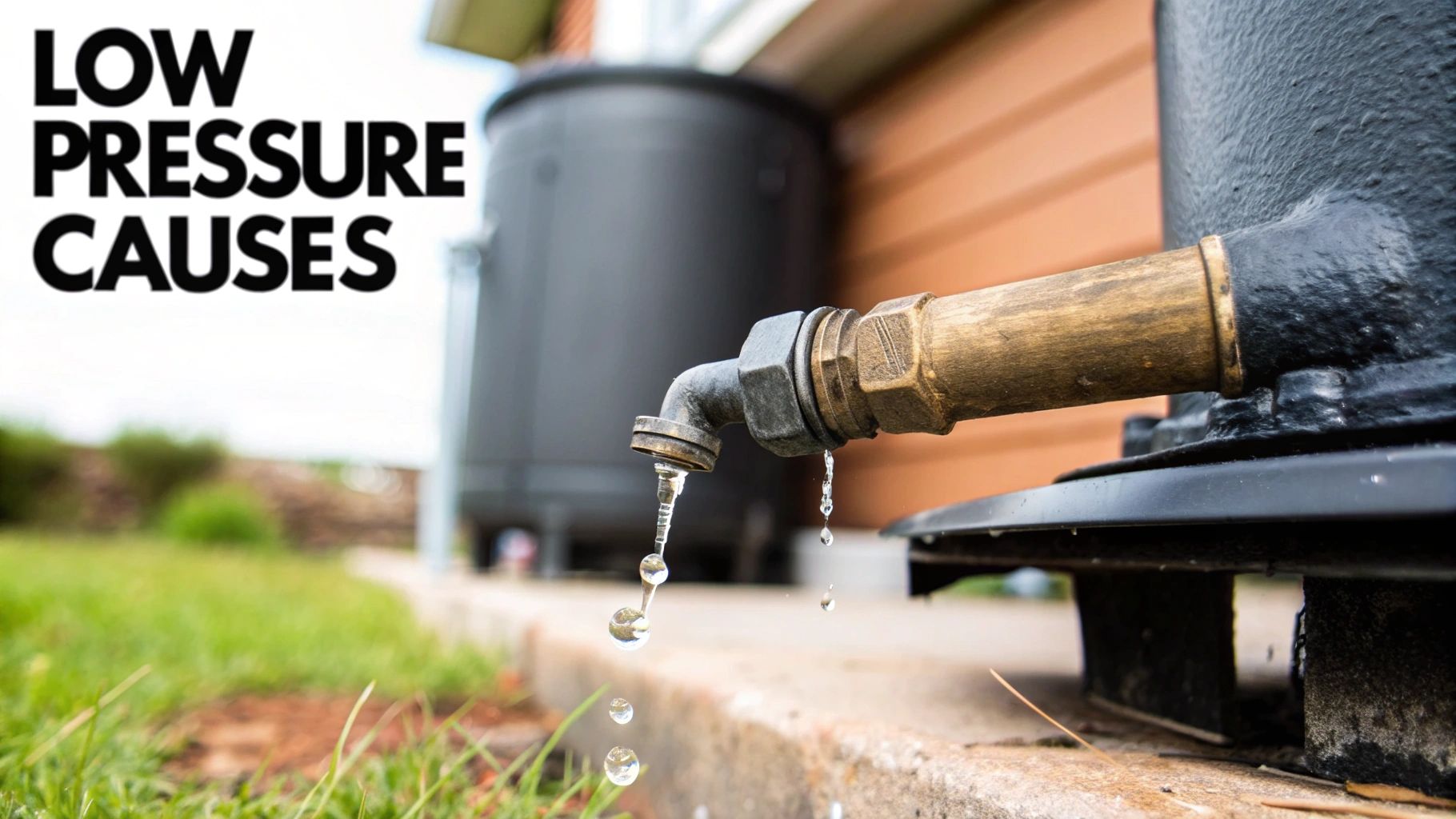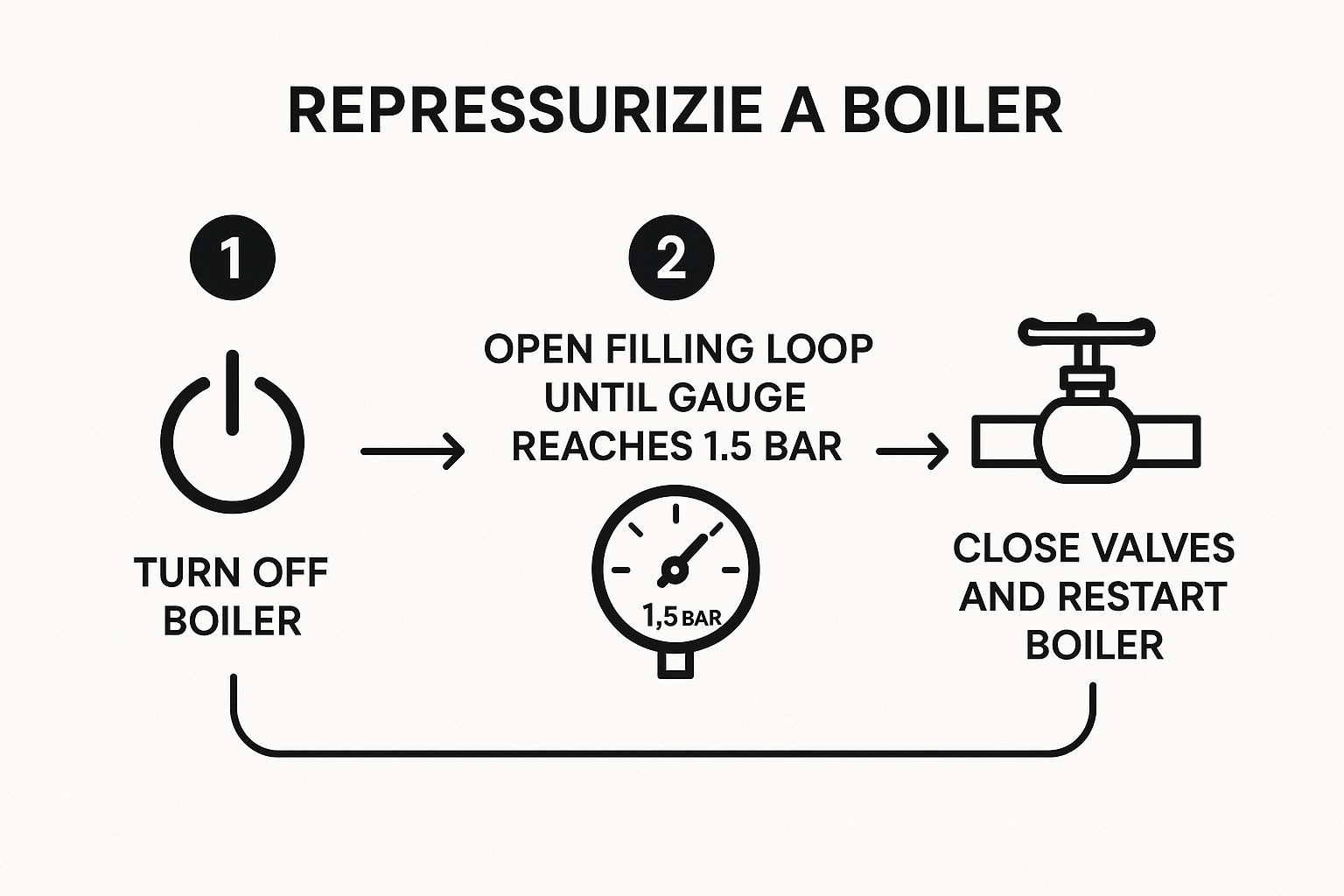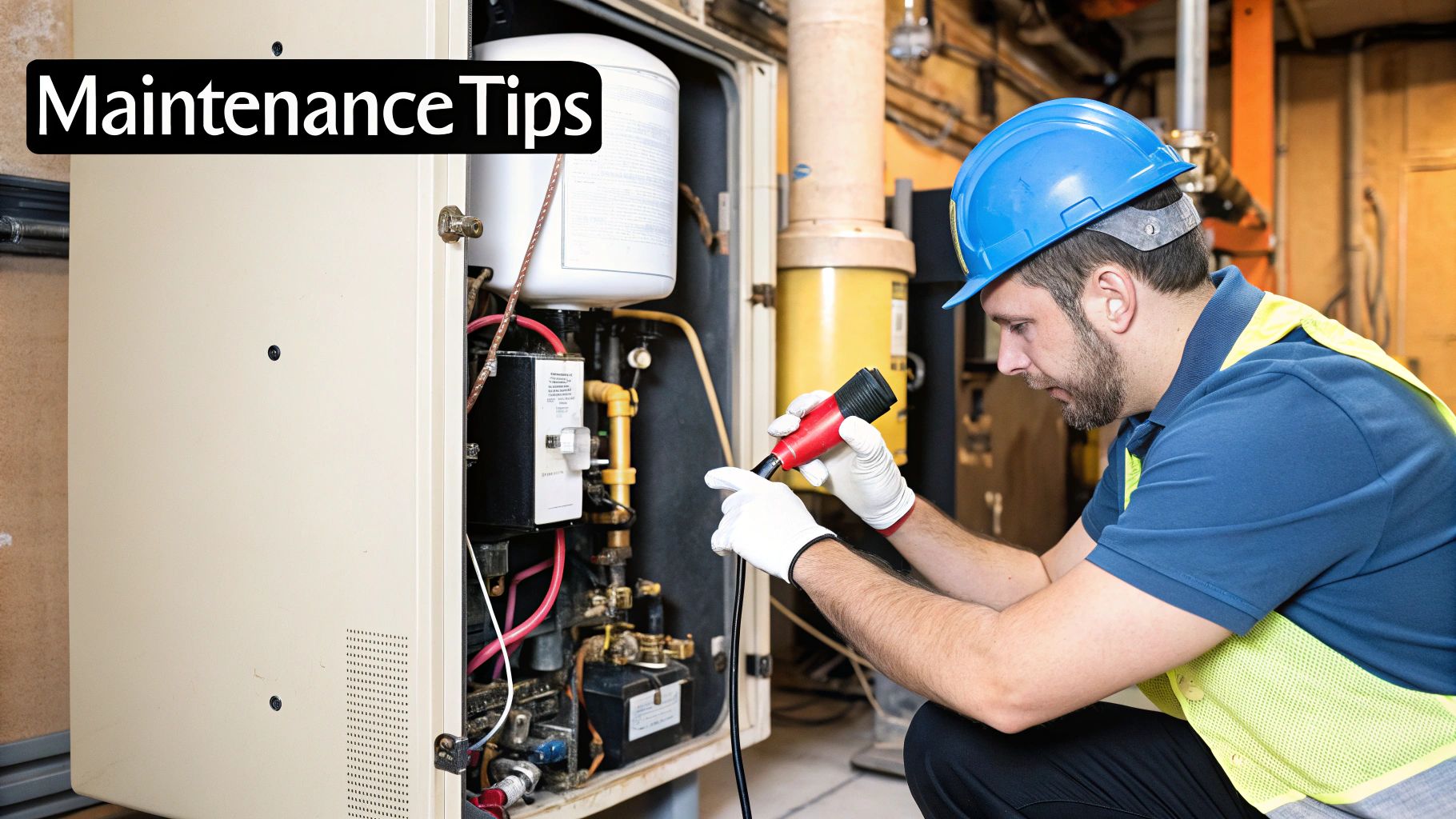If you've noticed your boiler pressure has dropped, it's usually down to one of two things: a water leak somewhere in your central heating system, or you've recently bled your radiators. Don't panic. This is one of the most common issues homeowners in the UK face, and more often than not, it's something you can sort out yourself.
The trick is to first understand why the pressure has dropped before you start turning any valves. However if you do not feel confident call us on: 01942 466 486 or visit out customer questions page at
https://jjkgasservices.co.uk/contact-us/
Getting to Grips With Low Boiler Pressure

Think of your boiler's pressure gauge as its pulse. It's a direct indicator of the balance of water and air inside the sealed central heating system. For everything to run smoothly and push hot water around your radiators, that pressure needs to stay stable – typically somewhere between 1 and 1.5 bar when the system is cold.
When the needle drops below that level, often into a red zone on the gauge, your boiler might shut itself down. It’s a built-in safety measure, but it leaves you without heating or hot water.
This is an incredibly widespread problem. With around 23 million homes in the UK running on gas boilers, and roughly 80% of those being pressure-sensitive combi boilers, a sudden drop is an experience many of us share. You can dig into the specifics of UK domestic heating in various government reports on home energy.
What's Causing the Pressure to Drop?
Pinpointing the cause is your first job. The reason your boiler pressure is too low will almost always be either a simple, one-off event or a symptom of a more persistent problem.
Here’s a quick rundown of the usual suspects.
Common Causes of Low Boiler Pressure
Potential Cause | What It Means For Your System | Is It a DIY Fix? |
|---|---|---|
Radiator Bleeding | Releasing trapped air also releases a small amount of water, causing a minor and expected pressure drop. | Yes. This is perfectly normal and easily fixed by repressurising the system. |
A Water Leak | Water is escaping from the system, causing the pressure to steadily decrease over time. | No. While you can repressurise as a temporary fix, a leak needs to be found and repaired by a professional. |
Faulty Component | A part inside the boiler, like the pressure relief valve, could be failing and letting water out. | No. This requires a Gas Safe registered engineer to diagnose and replace the faulty part. |
As you can see, a recent radiator bleed is the most common and harmless culprit. It’s a natural consequence of letting air out of the system.
If you haven’t touched your radiators, however, low pressure is a red flag for a water leak. This could be a tiny, almost invisible drip from a radiator valve, a pipe joint hidden under the floorboards, or a fault within the boiler itself.
A Pro Tip: If you find yourself having to top up the boiler pressure more than once every few months, you almost certainly have a leak that needs looking at, even if you can't see it. Constant repressurising is a temporary patch, not a permanent solution.
Safety First: What to Do Before You Touch Anything

Before you even think about fixing low boiler pressure, a few quick safety checks are in order. It’s a straightforward job, but a little bit of preparation is crucial for getting it right and, more importantly, keeping things safe.
First things first: switch off your boiler and let it cool down completely. This is a non-negotiable step.
Trying to repressurise a hot system is a classic mistake. When water is hot, it expands, and this can give you a false, artificially high reading on the pressure gauge. You need an accurate baseline, so always wait until your radiators are cool to the touch before you start.
Finding Your Key Components
While the system is cooling down, it’s a good time to track down the two things you'll definitely need. Getting these ready now will make the whole process much less of a headache.
Your Boiler's Manual: Think of this as your bible for the job. It will have diagrams showing you exactly where everything is on your specific model. Can't find the paper copy? No problem. A quick search online for your boiler's make and model will almost certainly pull up a PDF version.
The Filling Loop: This is the piece of kit that does the work. It’s a short, braided, and flexible hose, usually with a small valve at each end. On most modern combi boilers, the filling loop is integrated right into the unit, often tucked away underneath. For older systems, it might be a separate part that you have to attach yourself.
Having these items on hand before you start saves you from a frantic search later. A bit of prep work can make adjusting your boiler's pressure feel much less intimidating and ensures you're following the right procedure for your appliance.
Once you’ve got everything sorted, you're ready to tackle the main event. And remember, if at any point you feel out of your depth, don't hesitate to call in the professionals. Expert boiler services from teams like JJK Gas Services are there for a reason based in Wigan we cover the greater Manchester area. Such as- Standish – Shevington – Orell – Hindley – Hindley Green – Atherton – Tyldesley – walkden – Little Hulton and beyond
Your Step-by-Step Guide to Repressurising the Boiler
Right, with the boiler off and cool, you've done the prep work. Now for the main event. Repressurising your boiler sounds more intimidating than it is. In reality, you're just carefully letting a bit of mains water into the sealed heating system to get the pressure back where it should be. The trick is to go slowly and keep your eyes glued to that pressure gauge.
The whole point is to nudge the needle out of the red zone and have it sit comfortably in the green. For the vast majority of boilers here in the UK, you’re aiming for a cold pressure of around 1.5 bar. This gives the system just enough wiggle room for the pressure to rise slightly when the water heats up and expands.
Finding and Connecting the Filling Loop
First things first, you need to find the filling loop. This is the small pipe that creates a temporary link between your mains water and your central heating circuit. On most modern combi boilers, the filling loop is already built-in, usually tucked away underneath the boiler with a couple of small levers or taps.
If you have an older system, you might have an external filling loop – a separate braided metal hose. You'll need to connect this to two points: the mains water inlet and the heating system inlet. Just make sure they're hand-tight. You don't need to go at it with a wrench; a snug fit is all that's required to prevent any pesky drips.
A Pro Tip: Before you turn anything, give both ends of the external filling loop a quick wiggle to make sure they're properly attached. I've seen countless simple top-ups turn into a soggy mess because of a loose connection. It’s a two-second check that can save you a real headache.
Opening the Valves… Slowly!
With the loop connected and secure, it's time to let the water in. You’ll have two valves or levers to deal with. The key is to open them gently to start the flow. Often, one is a lever that needs a quarter-turn, while the other might be a small handle you twist like a tap.
The moment you open them, you'll hear water rushing into the system. Don't panic, that's exactly what should happen.
Your focus now needs to be squarely on the pressure gauge. You'll see the needle start to climb.
This handy visual breaks down the key actions you'll be taking.

As you can see, it's a straightforward sequence: prepare, fill, check, and close.
My advice is to work in short bursts. Let water in for just a few seconds, then close the valves to see where the needle has settled. The pressure can shoot up surprisingly fast, and it’s all too easy to go past your target. You want to stop precisely at 1.5 bar.
Gone a little bit over? It’s not the end of the world, and we'll talk about how to bleed a radiator to fix that in a moment. The most crucial action is to close both valves tightly as soon as you hit that 1.5 bar mark. This isolates the heating system again and stops the pressure from creeping up any further.
Don't Forget the Filling Loop
This next step is absolutely crucial and, frankly, non-negotiable. You must disconnect the filling loop.
If you used a separate, braided hose, make sure you unscrew it from both connection points completely. For boilers with a built-in filling loop, double-check that both levers or knobs are firmly back in the closed position.
This isn’t just good practice; it's a legal requirement under UK water regulations. Leaving that loop connected creates a direct path from your central heating system—full of treated water and sludge—back into your home's clean mains water supply. It's a serious contamination risk, so always disconnect.
Time to Restart and Watch Closely
With the filling loop safely out of the picture, go ahead and switch the power back on to your boiler. You'll hear it whir into life, and any error codes you had for low pressure should vanish from the display.
Now, for the next 24 to 48 hours, you're on watch.
Note the starting pressure: With the heating running, take a mental picture or an actual photo of the gauge. This is your new baseline.
Keep an eye out for changes: It's normal to see the needle twitch upwards slightly when the heating is on full blast (hot water expands, after all). What you're looking for is anything more dramatic.
Watch for a steady drop: The real tell-tale sign of a problem is if the pressure starts creeping down again, especially overnight when the system is cold. This is a classic symptom of a persistent leak somewhere in the system.
If the pressure holds steady after a day or two, give yourself a pat on the back—you've likely sorted it. But if you see that needle falling, even slowly, you haven't fixed the root cause of your boiler pressure too low problem. A recurring pressure drop is a clear signal that it's time to call in a Gas Safe registered engineer. Leaks don't fix themselves.
When to Call a Professional
Topping up the pressure after you’ve bled the radiators, for instance, is perfectly normal. But if you’re doing it repeatedly, that’s when you need to recognise the limits of DIY. Your safety, and the long-term health of your heating system, depend on spotting the signs that a professional is needed.
When to Bring in the Professionals
The most obvious red flag is a boiler that just won't hold its pressure. If you find yourself having to top it up every day or even every week, you've almost certainly got a leak somewhere in the system. It might not be a huge, dramatic puddle, but even a slow drip can cause serious water damage over time and put a strain on your boiler. Don't just keep topping it up—get it looked at.
Beyond a stubborn pressure drop, there are a few other warning signs that should have you reaching for the phone immediately.
Visible Water: Any sign of dripping or damp patches around the boiler, its pipes, or the radiators is a clear indicator of a leak.
Odd Noises: If your system has started gurgling, banging, or whistling, it’s trying to tell you something is wrong internally.
Stubborn Error Codes: The low-pressure warning should disappear after you’ve repressurised. If it stays put, or a different fault code pops up, it’s a job for an expert.
These symptoms often point to something more complex than simple pressure loss, like a failing seal, a problem with the expansion vessel, or a faulty pressure relief valve. In fact, historical data from UK housing surveys suggests that around 12-15% of all domestic boiler call-outs are related to pressure loss caused by these kinds of hidden faults. You can dig deeper into the data on domestic water system usage and common issues if you're interested.
A crucial point to remember: in the UK, it is a legal requirement that any person working on a gas appliance must be a Gas Safe registered engineer. This isn’t just good advice; it's the law, put in place to prevent gas leaks and carbon monoxide poisoning.
Never be tempted to open up the boiler casing and tinker with the internal parts yourself. It’s incredibly dangerous and illegal for a reason. Instead, head over to the official Gas Safe Register to find a qualified and vetted engineer in your area. It’s the only way to guarantee the job is done safely and correctly.
Got Questions About Boiler Pressure? We've Got Answers

To wrap things up, let's go over a few of the questions our engineers hear all the time when they're out on a job.
How Often Should I Be Topping Up My Boiler?
In a perfect world, you'd only need to repressurise your boiler once or twice a year, if that.
If you're finding yourself at the filling loop every few weeks or months, that's a red flag. It almost always points to a hidden leak somewhere in your central heating system that needs a professional eye.
What Happens if I Put Too Much Water In?
Don't panic—it's a common mistake. Putting too much pressure on the system isn't ideal, but modern boilers are built for this.
A component called the Pressure Relief Valve (PRV) will kick in and automatically release the excess water, usually through a small pipe to the outside. To fix it yourself, just bleed a little water from a radiator until you see the gauge needle drop back into that happy green zone.
Is Low Boiler Pressure Dangerous?
No, having your boiler pressure too low is not inherently dangerous. It’s definitely an inconvenience, though.
Modern boilers are designed with safety in mind and will simply shut down—a 'lockout'—to prevent any internal damage. So, while you won't have heating or hot water, it doesn't present a direct safety threat to you or your home.
For a deeper dive into home appliance safety, the official Health and Safety Executive (HSE) website is a fantastic resource for UK homeowners. It covers everything from gas safety to carbon monoxide awareness.
If you’re dealing with a boiler that just won't behave or you'd prefer the peace of mind that comes with a professional service, get in touch with JJK Gas Services. You can learn more about our expert boiler repair and maintenance services over at https://www.jjkgasservices.co.uk.
Article created usingOutrank


